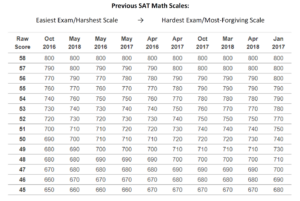The SAT® is changing in spring 2024. In addition to being adaptive and having some content changes, it will also be fully digital. One common question we’ve been hearing is, “Will the Digital SAT be easier than the current test?” According to the College Board, “The Digital SAT will continue to measure the skills and knowledge that research shows are crucial to college readiness and success and at the same level of rigor as the current SAT.” In general, the new exam is not designed to be easier, but there’s still a lot that’s unknown. Let’s dig in a bit deeper.
SAT Scoring Will Remain the Same
The new SAT will still continue to be scored on a scale of 400 to 1600. Similarly, the Math and Reading & Writing sections will continue to have a maximum score of 800 each. The score a student receives on the new SAT will be comparable to the current scores. For example, a score of 1400 on the new digital SAT will have the same value as a 1400 on the current test.
The Digital SAT Will Be Shorter
To make the SAT more approachable and less stressful for students, the Digital SAT will be 45 minutes shorter than the paper-and-pencil test and there are fewer questions. Test takers have more time to answer each question, meaning that the Digital SAT measures students’ skills and knowledge, not test-taking speed.
The New SAT Will Be Adaptive
The Digital SAT will utilize a multistage adaptive testing (MST) methodology. Being adaptive means the test can fairly and accurately measure the same things with a shorter test while preserving test reliability. Each section is divided into two equal-length and separately timed modules. The first module in each section contains a broad mix of easy, medium, and hard questions that allows students to demonstrate their achievement. Questions in the second module are either (on average) higher difficulty or lower difficulty than questions in the first module based on performance in the first module. This means that the test “adapts” to present questions that are more appropriate to a student’s performance level.
This is a major change to the current structure of the test. It’s important for students to understand that to achieve the highest score they have to do really well on the first module, or they will not achieve the score they want.
Test Content Changes
The digital exam will test new content that has been de-emphasized in the past. For example, the Reading & Writing section will feature a wider range of passage types, including poetry. The Math section will continue to rest heavily on algebra concepts, but will place greater focus on geometry and trigonometry.
Easier Does Not Mean Better
As we’ve said, the new SAT is not designed to be easier. However, it’s also important to understand that an easier SAT is not generally good news. On all prior iterations of the SAT, the College Board has utilized a practice known as equating to ensure that a given score on one SAT represents the same level of knowledge and skills as that same score on a different version of the test. Since the College Board has stated that the digital test scores will be equivalent to their paper counterparts, it seems safe to hypothesize that a similar practice will be put in place with the new test.
In the past, if a certain test was widely considered to be easy by test-takers, the scale for that test was particularly harsh. The table below illustrates the range of math scales that have been found on past SAT exams:

When an SAT is “easy,” the scoring is harsher—a single missed question could drop a student’s score by 20 points. If the rumors about the digital SAT’s difficulty prove true, it’s likely that the scoring will be similarly strict, meaning that students hoping for top scores will need to strive for perfection.
Want to learn more? Visit our Digital SAT Resource Hub.



